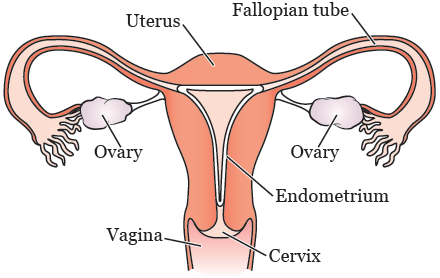This information describes what to expect before, during, and after your endometrial biopsy (EN-doh-MEE-tree-ul BY-op-see).
About Your Endometrial Biopsy
During your endometrial biopsy, your healthcare provider will take out a small piece of tissue from your endometrium (en-doh-MEE-tree-um). Your endometrium is the layer of tissue that lines your uterus (see Figure 1).

The tissue that’s taken out is sent to a pathologist (doctor that studies body tissues to diagnose diseases). The pathologist will examine it under a microscope to look for cancer cells.
Before Your Procedure
Tell your healthcare provider if:
- You’re allergic to iodine. Usually, we use the antiseptic povidone-iodine (Betadine®) during this procedure. An antiseptic is a liquid that kills bacteria and other germs. If you’re allergic to iodine, your healthcare provider will use a different antiseptic.
- You’re allergic to latex.
- There’s a chance that you’re pregnant. If you still get your period and are between 11 and 50 years old, you’ll need to take a urine pregnancy test. This is done to make sure you’re not pregnant. If you’re pregnant, you can’t have this procedure. An endometrial biopsy can’t be done on someone who’s pregnant.
You won’t need to do anything to get ready for this procedure. You can eat, drink, and take your medications as usual.
During Your Procedure
You’ll have your endometrial biopsy done in an exam room. You’ll lie on your back just like you would for a routine pelvic exam. You’ll be awake during the procedure.
First, your healthcare provider will put a speculum into your vagina. A speculum is a tool that gently spreads apart your vaginal walls. It helps your healthcare provider see your cervix. Your cervix is the bottom part of your uterus (see Figure 1).
Next, your healthcare provider will clean your cervix with Betadine. Then, they’ll use a thin, flexible tool, called a pipelle. They’ll insert the pipelle through your cervix and into your uterus to take a small piece of tissue from your endometrium. You’ll feel some cramping while your healthcare provider takes out the tissue. After the tissue is taken out, your healthcare provider will take out the speculum.
The procedure usually takes about 5 to 10 minutes.
After Your Procedure
- You may have a small amount of vaginal spotting or bleeding. This can last for a few days after your procedure. You may use sanitary pads, if needed. Don’t use tampons.
- You may have some cramping after your procedure. You can take over-the-counter medications such as ibuprofen (Advil® or Motrin®) or acetaminophen (Tylenol®) to help with this.
- Don’t place anything in your vagina for 48 hours (2 days) unless your healthcare provider tells you it’s okay. This includes douches and tampons.
- Talk with your healthcare provider about when it’s safe for you to have vaginal intercourse (sex) again.
- Your healthcare provider’s office will contact you with your biopsy results in about 1 week.
When to Call Your Healthcare Provider
Call your healthcare provider if you have:
- A fever of 101° F (38.3° C) or higher
- Vaginal bleeding that’s heavier than your usual menstrual flow (period)
- Pain that doesn’t get better after taking medication for cramping
- Any foul-smelling or pus-like drainage from your vagina